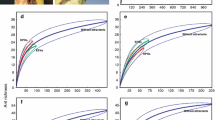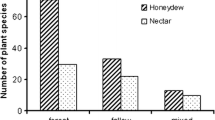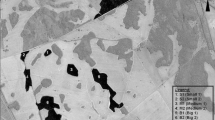Abstract
Ecological dominance in ants is often fuelled by carbohydrate intake. Most studies have focused on the importance of invasive ant mutualistic associations with trophobionts whereas few studies have investigated the importance of floral nectar on invasion success. In this study, utilisation of temporarily available floral nectar by the invasive Argentine ant, Linepithema humile, was compared to that of the dominant native ant, Anoplolepis custodiens, within the Cape Floristic Region (CFR), a biodiversity hotspot. The effect of these two focal ant species on species composition and abundance of ground foraging ants as well as floral arthropod visitors in inflorescences of Proteacea species was assessed. Foraging activity, and trophic ecology inferred from the abundance of natural stable isotopes of Carbon (δ13C) and Nitrogen (δ15N), and the ratio of Carbon to Nitrogen (C:N) were compared between the two ant species during three flowering periods. Linepithema humile significantly reduced the abundance and species diversity of both above-ground and floral arthropod species abundance and composition. Linepithema humile increased its foraging activity with increasing nectar availability, switching its diet to a more herbivorous one. Anoplolepis custodiens did not respond as effectively to increasing floral nectar or negatively impact floral arthropod visitors. This study showed that the availability of floral nectar and ability of L. humile to more effectively utilise this temporarily available resource than native ants, can contribute significantly to the further spread and persistence of L. humile in natural environments in the CFR.





Similar content being viewed by others
References
Blüthgen N, Fiedler K (2004) Preferences for sugars and amino acids and their conditionality in a diverse nectar feeding ant community. J Anim Ecol 73:155–166
Bond W, Slingsby P (1984) Collapse of an Ant-Plant Mutalism: the Argentine Ant (Iridomyrmex Humilis) and Myrmecochorous Proteaceae. Ecol 65(4):1031–1037
Buys B (2015) Competition for nectar between Argentine ants, Iridomyrmex humilis, and honeybees Apis mellifera on black ironbark Eucalyptus sideroxylon. South Afr J Zool 22(2):173–174
Callaway RM, Aschehoug ET (2000) Invasive plants versus their new and old neighbors: a mechanism for exotic invasion. Science 290:521–523
Clarke KR, Gorley RN (2006) Primer, version 6.1.10: user manual and tutorial. Primer-E, Plymouth
Coetzee JH, Giliomee JH (1985) Insects in association with the inflorescence of Protea repens (L.) (Proteaceae) and their role in pollination. J Entomol Soc S Afr 48:303–314
Cowling RM, MacDonald IAW, Simmons MT (1996) The Cape Peninsula, South Africa: physiographical, biological and historical background to an extraordinary hot-spot of biodiversity. Biodivers Conserv 5:527–550
Davidson DW (1997) Foraging ecology and community organization in desert seed-eating ants. Ecology 58:725–737
Davidson DW, Cook SC, Snelling RR, Chua TH (2003) Explaining the abundance of ants in lowland tropical rainforest canopies. Science 300:969–972
Davis MA, Grime JP, Thompson K (2000) Fluctuating resources in plant communities: a general theory of invasibility. J Ecol 88:528–534
de Kock AE (1990) Interactions between the introduced Argentine an lridomyrmex humilis Mayr, and two indigenous Fynbos ant species. J Entomol Soc S Afr 53:107–111
de Kock AE, Giliomee JH (1989) A survey of the Argentine ant, Iridomyrmex humilis (Mayr), (Hymenoptera: formicidae) in South African Fynbos. J Entomol Soc S Afr 52:157–164
Donnelly D (1983) Comparison of community structure of the epigaeic invertebrate fauna, with particular reference to ants and beetles, between Fynbos sites under different management practices. Unpublished MSc Thesis, Stellenbosch University
Donnelly D, Giliomee JH (1985) Community structure of epigaeic ants (Hymenoptera:formicidae) in fynbos vegetation in the Jonkershoek Valley. J Entomol Soc S Afr 48:247–257
Dukes JS, Mooney HA (1999) Does global change increase the success of biological invaders? TREE 14:135–139
Dussutour A, Simpson SJ (2008) Carbohydrate regulation in relation to colony growth in ants. J Exp Biol 211:2224–2232
Dussutour A, Simpson SJ (2012) Ant workers die young and colonies collapse when fed a high-protein diet. Proc R Soc B 279:2402–2408
Feldhaar H, Gebauer G, Blüthgen N (2010) Stable isotopes: past and future in exposing secrets of ant nutrition (Hymenoptera: formicidae). Myrmecol News 13:3–13
Fry B (2006) Stable Isotope Ecology. New York, Springer Science + Business Media
Funk JL (2008) Differences in plasticity between invasive and native plants from a low resource environment. J Ecol 96(6):1162–1173
Geerts S (2011). Assembly and disassembly of bird pollination communities at the Cape of Africa. PhD Thesis. Stellenbosch University
Geerts S, Pauw A (2011) Farming with native bees (Apis mellifera subsp. capensis) has varied effects on nectar-feeding bird communities in South African fynbos vegetation. Popul Ecol 53:333–339
Gibb H, Cunningham SA (2009) Arboreal sugars affect ecological dominance in ant assemblages across a restoration chronosequence. Insectes Soc 56:405–412
Grover CD, Kay AD, Monson JA, Marsh TC, Holway DA (2007) Linking nutrition and behavioural dominance: carbohydrate scarcity limits aggression and activity in Argentine ants. Proc R Soc Lond B 274:2951–2957
Helanterä H, Strassmann JE, Carrillo J, Queller DC (2009) Unicolonial ants: where do they come from, what are they and where are they going? Trends Ecol Evol 24(6):341–349
Helms KR (2013) Mutualisms between ants (Hymenoptera:formiciae) and honeydew-producing insects: Are they important in invasions? Myrmecol News 18:61–71
Helms KR, Vinson SB (2002) Widespread association of the invasive ant Solenopsis invicta with an invasive mealybug. Ecology 83:2425–2438
Helms KR, Vinson SB (2008) Plant resources and colony growth in an invasive ant: the importance of honeydew producing Hemiptera in carbohydrate transfer across trophic levels. Environ Entomol 37:487–493
Helms KR, Hayden CP, Vinson SB (2010) Plant-based food resources, trophic interactions among alien species, and the abundance of an invasive ant. Biol Invasions 13(1):67–79
Hölldobler B, Wilson EO (1990) The ants. Harvard University Press, Cambridge
Holway DA, Lach L, Suarez AV, Tsutsui ND, Case TJ (2002) The causes and consequences of ant invasions. Ann Rev Ecol Syst 33:181–233
Kaplan I, Eubanks MD (2005) Aphids alter the community-wide impact of fire ants. Ecology 86:1640–1649
Kay AD, Zumbusch TB, Heinen JL, Marsh TC, Holway DA (2010) Nutrition and interference competition have interactive effects on the behavior and performance of Argentine ants. Ecology 91:57–64
Lach L (2003) Invasive ants: unwanted partners in ant-plant interactions? Ann Mo Bot Gard 90:91–108
Lach L (2005) Interference and exploitation competition of three nectar thieving invasive ant species. Insectes Soc 52:257–262
Lach L (2007) A mutualism with a native membracid facilitates pollinator displacement by Argentine ants. Ecology 88:1994–2004
Lach L (2008) Argentine ants displace floral arthropods in a biodiversity hotspot. Divers Distrib 14:281–290
Lach L (2013) A comparison of floral resource exploitation by native and invasive Argentine ants. Arthropod Plant Interact 7:177–190
Lach L, Hobbs R, Majer JD (2009) Herbivory-induced extrafloral nectar increases native and invasive ant worker survival. Popul Ecol 51:237–243
Lach L, Tillberg CV, Suarez AV (2010) Contrasting effects of an invasive ant on a native and an invasive plant. Biol Invasions 12:3123–3133
Le Breton J, Orivel J, Chazeau J, Dejean A (2007) Unadapted behaviour of native, dominant ant species during the colonization of an aggressive, invasive ant. Ecol Res 22(1):107–114
Le Maitre DC, Van Wilgen BW, Chapman RA, McKelly DH (1996) Invasive plants and water resources in the Western Cape Province, South Africa: modeling the consequences of a lack of management. J Appl Ecol 33:161–172
Luruli N (2007) Distribution of the Argentine ant Linepithema humile (Mayr) in South Africa. Unpublished MSc Thesis. Stellenbosch University
Mata TM, Haddad NM, Holyoak M (2013) How invader traits interact with resident communities and resource availability to determine invasion success. Oikos 122:149–160
McCutchan JH, Lewis WM, Kendall C, McGrath CC (2003) Variation in trophic shift for stable isotope ratios of carbon, nitrogen, and sulphur. Oikos 102:378–390
McGlynn TP, Parra EL (2016) Mechanisms of carbohydrate-fuelled ecological dominance in a tropical rainforest canopy-foraging ant. Ecol Entomol 41:226–230
Menke SB, Suarez AV, Tillberg CV, Chou CT, Holway DA (2010) Trophic ecology of the invasive Argentine ant: spatio-temporal variation in resource assimilation and isotopic enrichment. Oecologia 164(3):763–771
Ness JH, Bronstein JL (2004) The effects of invasive ants on prospective ant mutualists. Biol Invasions 6:445–461
Ottonetti L, Tucci L, Chelazzi G, Santini G (2008) Stable isotopes analysis to assess the trophic role of ants in a Mediterranean agroecosystem. Agric For Entomol 10:29–36
Post DM (2002) Using stable isotopes to estimate trophic position: models, methods, and assumptions. Ecology 83:703–718
R Core Team (2012) R: a language and environment for statistical computing. R Foundation for Statistical Computing, Vienna, Austria. http://www.R-project.org/
Rebelo T (2001) Proteas: a field guide to the proteas of southern Africa. Fernwood Press, Vlaeberg
Rowles A, Silverman J (2009) Carbohydrate supply limits invasion of natural communities by Argentine ants. Oecologia 161:161–171
Savage AM, Whitney KD (2011) Trait mediated indirect interactions in invasions: unique behavioural responses of an invasive ant to plant nectar. Ecosphere 2(9):106
Savage AM, Johnson SD, Whitney KD, Rudgers JA (2011) Do invasive ants respond more strongly to carbohydrate availability than co-occurring non-invasive ants? A test along an active Anoplolepis gracilipes invasion front. Austral Ecol 36:310–319
Savage AM, Rudgers JA, Whitney KD (2009) Elevated dominance of extrafloral nectary-bearing plants is associated with increased abundances of an invasive ant and reduced native ant richness. Divers Distrib 15:751–761
Shik JZ, Silverman J (2012) Towards a nutritional ecology of invasive establishment: aphid mutualists provide better fuel for incipient Argentine ant colonies than insect prey. Biol Invasions 15:829–836
Smith CR, Suarez AV (2010) The trophic ecology of castes in harvester ant colonies. Funct Ecol 24:122–130
Styrsky JD, Eubanks MD (2007) Ecological consequences of interactions between ants and honeydew-producing insects. Proc R Soc B: Biol Sci 274(1607):151–164
Tillberg CV (2004) Friend or Foe? A behavioural and stable isotopic investigation of an ant-plant symbiosis. Oecologia 140:506–515
Tillberg CV, McCarthy DP, Dolezal AG, Suarez AV (2006) Measuring trophic ecology of ants using stable-isotopes. Insectes Soc 53:65–69
Tillberg CV, Holway DA, LeBrun EG, Suarez AV (2007) Trophic ecology of invasive Argentine ants in their native and introduced ranges. PNAS 104:20856–20861
Tilman D (2004) Niche tradeoffs, neutrality, and community structure: a stochastic theory of resource competition, invasion, and community assembly. Proc Natl Acad Sci 101(30):10854–10861
Tsutsui ND, Suarez AV, Holway DA, Case TJ (2001) Relationships among native and introduced populations of the Argentine ant (Linepithema humile) and the source of introduced populations. Mol Ecol 10(9):2151–2161
Visser D (1992) The arthropods associated with Protea nitida. MSc thesis, Agricultural Sciences, Stellenbosch University
Visser D, Wright MG, Giliomee JH (1996) The effect of the Argentine ant, Linepithema humile (Mayr) (Hymenoptera: formicidae), on flower-visiting insects of Protea nitida Mill. (Proteaceae). Afr Entomol 4:285–287
Vorster C (2011) Distribution and bait preference of the Argentine ant in natural vegetation. MSc Thesis. Stellenbosch University
Wilder SM, Holway DA, Suarez AV, LeBrun EG, Eubanks MD (2011a) Intercontinental differences in resource use reveal the importance of mutualisms in fire ant invasions. PNAS 108:20639–20644
Wilder SM, Holway DA, Suarez AV, Eubanks MD (2011b) Macronutrient content of plant-based food affects growth of a carnivorous arthropod. Ecology 92:325–332
Wilder SM, Barnum TR, Holway DA, Suarez AV, Eubanks MD (2013) Introduced fire ants can exclude native ants from critical mutualist-provided resources. Oecologia 172:197–205
Witt ABR, Giliomee JH (1999) Soil-surface temperatures at which six species of ants (Hymenoptera: formicidae) are active. Afr Entomol 7:161–164
Witt ABR, Giliomee JH (2004) The impact of an invasive ant, Linepithema humile (Mayr), on the dispersal of Phylica pubescens Aiton seeds in South Africa. Afr Entomol 12:179–185
Acknowledgements
We thank James Mugabe, Matthew Watkins-Baker, Kellyn Whitehead, Kimberley Cloete, David and Nikki Phair for field assistance; John Langham and Ian Newton for isotope analysis; Cape Nature and City of Cape Town for sampling permits; and Shula Johnson for logistical support. This study was funded by the Stellenbosch University’s HOPE project and the Centre of Excellence for Invasion Biology.
Author information
Authors and Affiliations
Corresponding author
Rights and permissions
About this article
Cite this article
Mothapo, N.P., Wossler, T.C. Patterns of floral resource use by two dominant ant species in a biodiversity hotspot. Biol Invasions 19, 955–969 (2017). https://doi.org/10.1007/s10530-016-1336-6
Received:
Accepted:
Published:
Issue Date:
DOI: https://doi.org/10.1007/s10530-016-1336-6




